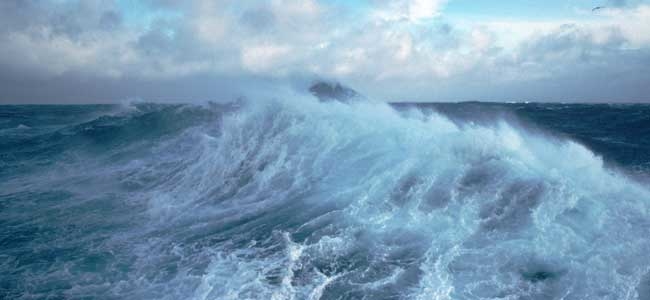Increased production of smelly sulfur compound in Southern Ocean tied to climate change
 (Download Image)
The cold and windy Southern Ocean favors the exchange of CO2 with the atmosphere. At high latitudes (photo), a recent and persistent increase in winds has produced a saturation of the Southern Ocean sink for CO2. Photo courtesy of N.Metzl, August 2000, oceanographic cruise OISO-5.
(Download Image)
The cold and windy Southern Ocean favors the exchange of CO2 with the atmosphere. At high latitudes (photo), a recent and persistent increase in winds has produced a saturation of the Southern Ocean sink for CO2. Photo courtesy of N.Metzl, August 2000, oceanographic cruise OISO-5.
In a recent report, a Livermore researcher, along with colleagues from Los Alamos and Oak Ridge national laboratories and the New Mexico Institute of Mining and Technology, found through computer modeling that dimethyl sulfide (DMS) will increase significantly in certain parts of the ocean and decrease in others if the world continues with a business-as-usual fossil fuel dependency.
DMS, a sulfur-containing compound that affects the heat balance of the Earth, is one of the major precursors for aerosols and cloud condensation in the marine boundary layer over much of the remote ocean. DMS is produced by marine plankton and represents the largest source of natural sulfur emissions. Upon reaching the atmosphere, DMS is converted into sulfate aerosols, which reflect sunlight and can stimulate cloud formation.
"We found that DMS is locally much more sensitive to climate change than in previous modeling studies," said LLNL's Philip Cameron-Smith. "The shift in emissions will change the heating patterns."
The Southern Ocean is a locale where the effects of global climate change are noticeable. In this region, there is substantial biological production, carbon drawdown and convective return of nutrients.
Using climate simulations with a global ocean biogeochemical model, scientists looked at the impact of present-day (355 parts per million) and future (970 parts per million) concentrations of carbon dioxide in the atmosphere on DMS levels and emissions in the Southern Hemisphere.
What they found was quite a surprise: In the future scenario, the average DMS emission to the atmosphere was 150 percent more than current levels in the Southern Ocean. Team members found that sea ice changes and ocean ecosystem composition shifts caused by changes in temperature, mixing, nutrient and light regimes caused the increase in DMS in their simulation.
"DMS emissions in the Southern Ocean are significantly more sensitive to climate change than previously thought," Cameron-Smith said. "The melting of the southern sea-ice has a large impact on DMS flux in the model, because it opens up a lot of cold open water in which the DMS-producing plankton thrive (particularly a species called Phaeocystis). This compensates for the warming of the ocean in other areas where Phaeocystis stops growing so well."
In the future, scientists may have to consider how ocean acidification, which is tied directly to climate warming, could affect the plankton community, and therefore DMS production.
The research appears in a recent issue of the journal, Geophysical Research Letters.
Contact
Anne M Stark[email protected]
925-422-9799
Related Links
Changes in dimethyl sulfide oceanic distribution due to climate changeOcean science, If Gaia could talk
Too Hot to Handle
Ocean temperatures and sea level increases 50 percent higher than previously estimated
Climate models consistent with ocean warming observations
Tags
Earth and Atmospheric ScienceClimate change
Physical and Life Sciences
Science
Featured Articles







